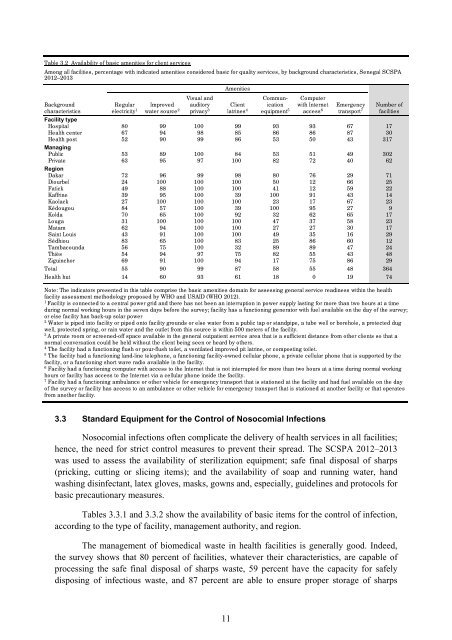CSwMR
CSwMR
CSwMR
Create successful ePaper yourself
Turn your PDF publications into a flip-book with our unique Google optimized e-Paper software.
Table 3.2 Availability of basic amenities for client services<br />
Among all facilities, percentage with indicated amenities considered basic for quality services, by background characteristics, Senegal SCSPA<br />
2012–2013<br />
Background<br />
characteristics<br />
Regular<br />
electricity 1<br />
Improved<br />
water source 2<br />
Visual and<br />
auditory<br />
privacy 3<br />
Amenities<br />
Client<br />
latrines 4<br />
Communication<br />
equipment 5<br />
Computer<br />
with Internet<br />
access 6<br />
Emergency<br />
transport 7<br />
Number of<br />
facilities<br />
Facility type<br />
Hospital 80 99 100 99 93 93 67 17<br />
Health center 67 94 98 85 86 86 87 30<br />
Health post 52 90 99 86 53 50 43 317<br />
Managing<br />
Public 53 89 100 84 53 51 49 302<br />
Private 63 95 97 100 82 72 40 62<br />
Region<br />
Dakar 72 96 99 98 80 76 29 71<br />
Diourbel 24 100 100 100 50 12 66 25<br />
Fatick 49 88 100 100 41 12 59 22<br />
Kaffrine 39 95 100 39 100 91 43 14<br />
Kaolack 27 100 100 100 23 17 67 23<br />
Kédougou 84 57 100 39 100 95 27 9<br />
Kolda 70 65 100 92 32 62 65 17<br />
Louga 31 100 100 100 47 37 58 23<br />
Matam 62 94 100 100 27 27 30 17<br />
Saint Louis 43 91 100 100 49 35 16 29<br />
Sédhiou 83 65 100 83 25 86 60 12<br />
Tambacounda 56 75 100 32 89 89 47 24<br />
Thiès 54 94 97 75 82 55 43 48<br />
Ziguinchor 69 91 100 94 17 75 86 29<br />
Total 55 90 99 87 58 55 48 364<br />
Health hut 14 60 93 61 18 0 19 74<br />
Note: The indicators presented in this table comprise the basic amenities domain for assessing general service readiness within the health<br />
facility assessment methodology proposed by WHO and USAID (WHO 2012).<br />
1<br />
Facility is connected to a central power grid and there has not been an interruption in power supply lasting for more than two hours at a time<br />
during normal working hours in the seven days before the survey; facility has a functioning generator with fuel available on the day of the survey;<br />
or else facility has back-up solar power<br />
2<br />
Water is piped into facility or piped onto facility grounds or else water from a public tap or standpipe, a tube well or borehole, a protected dug<br />
well, protected spring, or rain water and the outlet from this source is within 500 meters of the facility.<br />
3<br />
A private room or screened-off space available in the general outpatient service area that is a sufficient distance from other clients so that a<br />
normal conversation could be held without the client being seen or heard by others.<br />
4<br />
The facility had a functioning flush or pour-flush toilet, a ventilated improved pit latrine, or composting toilet.<br />
5<br />
The facility had a functioning land-line telephone, a functioning facility-owned cellular phone, a private cellular phone that is supported by the<br />
facility, or a functioning short wave radio available in the facility.<br />
6<br />
Facility had a functioning computer with access to the Internet that is not interrupted for more than two hours at a time during normal working<br />
hours or facility has access to the Internet via a cellular phone inside the facility.<br />
7<br />
Facility had a functioning ambulance or other vehicle for emergency transport that is stationed at the facility and had fuel available on the day<br />
of the survey or facility has access to an ambulance or other vehicle for emergency transport that is stationed at another facility or that operates<br />
from another facility.<br />
3.3 Standard Equipment for the Control of Nosocomial Infections<br />
Nosocomial infections often complicate the delivery of health services in all facilities;<br />
hence, the need for strict control measures to prevent their spread. The SCSPA 2012–2013<br />
was used to assess the availability of sterilization equipment; safe final disposal of sharps<br />
(pricking, cutting or slicing items); and the availability of soap and running water, hand<br />
washing disinfectant, latex gloves, masks, gowns and, especially, guidelines and protocols for<br />
basic precautionary measures.<br />
Tables 3.3.1 and 3.3.2 show the availability of basic items for the control of infection,<br />
according to the type of facility, management authority, and region.<br />
The management of biomedical waste in health facilities is generally good. Indeed,<br />
the survey shows that 80 percent of facilities, whatever their characteristics, are capable of<br />
processing the safe final disposal of sharps waste, 59 percent have the capacity for safely<br />
disposing of infectious waste, and 87 percent are able to ensure proper storage of sharps<br />
11


